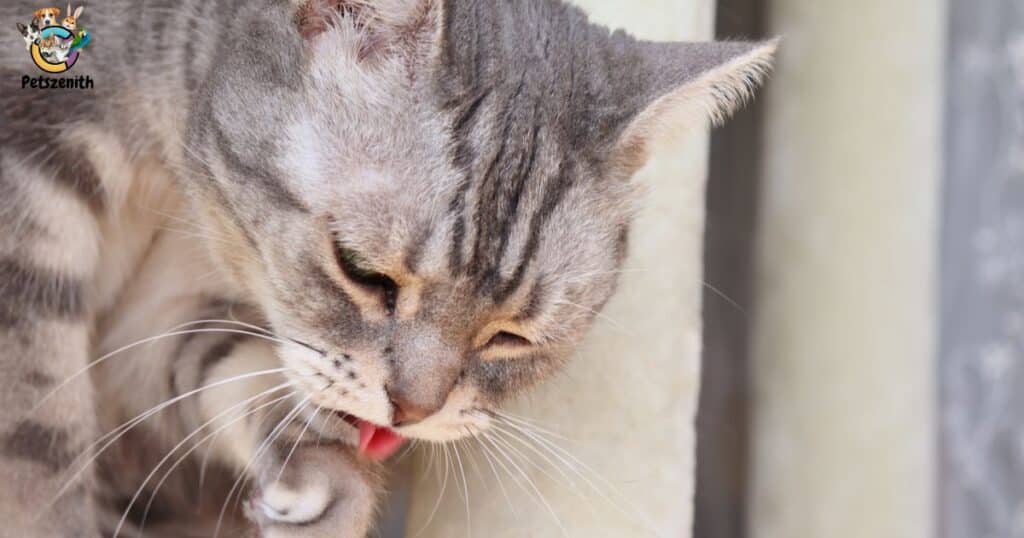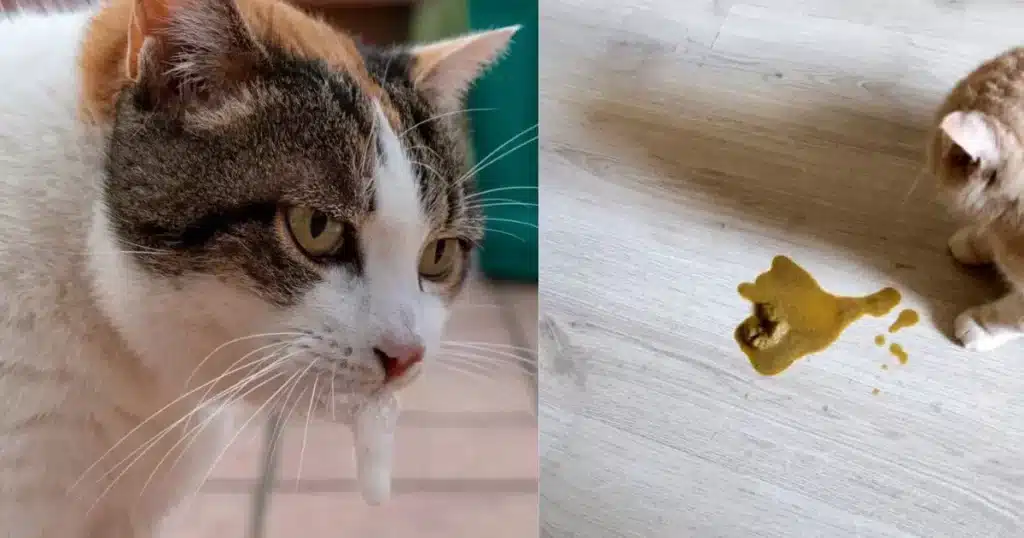When your cat accidentally swallows something harmful, such as a toxic substance or a foreign object, knowing how to make them vomit can be vital to their health. By inducing vomiting, you can help expel the harmful substance from their system before it causes serious harm. However, it’s essential to approach this process with caution and to follow the proper techniques to ensure your cat’s safety. In this article, we’ll explore the steps you can take to safely make your cat vomit when necessary.
Whether your furry friend accidentally ingested something harmful, it’s essential to know the right steps. In this guide, we’ll cover easy methods to induce vomiting in cats and ensure their well-being. Dive in to discover reliable techniques for How to Make Your Cat Vomit.
Understanding Why Making a Cat Vomit May Be Necessary
Before diving into the methods of inducing vomiting in cats, it’s essential to understand the reasons behind it. Cats may ingest toxic substances such as household chemicals, certain plants, or even human medications accidentally. In such situations, vomiting can help expel the harmful substance from their system before it can cause further harm.
What should I give my cat to vomit?
If you’re wondering what to give your cat to induce vomiting, it’s important to proceed with caution. While hydrogen peroxide is commonly used, always consult a veterinarian first. They can provide guidance on the appropriate dosage based on your cat’s weight. It’s crucial to prioritize your cat’s safety and well-being when considering inducing vomiting.
When Not to Induce Vomiting?

When considering your cat’s health, it’s vital to know when not to induce vomiting. Certain situations require professional intervention rather than home remedies. If your cat ingested a sharp object, corrosive substance, or is already showing signs of distress, seek immediate veterinary assistance. Knowing when not to induce vomiting can prevent further harm and ensure your cat receives the appropriate care.
Recommended post: WHAT VACCINES DO CATS NEED TO BE BOARDED?
How to make your cat vomit with water?
When attempting to make your cat vomit with water, it’s crucial to proceed with caution and follow these steps:
- Consult Your Veterinarian: Before attempting any home remedies, contact your veterinarian for guidance. They can advise you on whether inducing vomiting is appropriate for your cat’s situation and provide specific instructions tailored to your pet’s needs.
- Use Lukewarm Water: Fill a syringe or dropper with lukewarm water. It’s important to use water at a comfortable temperature to prevent discomfort for your cat.
- Administer Water Orally: Gently hold your cat and administer the water orally. You can do this by tilting your cat’s head back slightly and carefully inserting the syringe or dropper into the side of their mouth.
- Give Small Amounts: Slowly dispense small amounts of water into your cat’s mouth, allowing them time to swallow. Avoid giving too much water at once to prevent choking.
- Encourage Vomiting: After administering the water, gently massage your cat’s throat or softly pat their chest to encourage vomiting. Be patient, as it may take some time for the water to stimulate the gag reflex and induce vomiting.
- Monitor Your Cat: Keep a close eye on your cat during and after the process. If they do not vomit within a reasonable amount of time or show signs of distress, contact your veterinarian immediately for further advice.
- Seek Professional Help if Necessary: If your cat has ingested a toxic substance or if you’re unsure about inducing vomiting at home, seek immediate veterinary assistance. Professional care may be necessary to ensure the safety and well-being of your cat.
Is my cat’s vomiting an emergency?
It’s essential to understand when to seek immediate veterinary care. While occasional vomiting may not be cause for alarm, frequent or persistent vomiting could indicate a more serious underlying issue. If your cat is vomiting repeatedly, lethargic, or showing other concerning symptoms, it’s best to err on the side of caution and contact your veterinarian promptly. By addressing potential emergencies early, you can ensure the health and well-being of your furry friend.
Do I need to bring my cat to the vet for vomiting?

It’s a common concern among cat owners. While occasional vomiting may not be cause for alarm, persistent or severe vomiting could indicate an underlying health issue. If your cat vomits frequently, shows signs of distress, or exhibits other symptoms such as lethargy or loss of appetite, it’s best to err on the side of caution and consult with your veterinarian. Professional guidance can help determine the cause of your cat’s vomiting and provide appropriate treatment if needed. Prioritize your cat’s well-being by seeking veterinary advice whenever you’re unsure about their health.
When Should You Make Your Cat Vomit?
Making your cat vomit should only be considered in specific scenarios. If you suspect that your cat has ingested something toxic within the last two hours, inducing vomiting may be appropriate. However, always consult with a veterinarian before attempting to make your cat vomit, as some substances can cause more harm if vomited back up.
Safety Precautions
Safety should be your top priority when attempting to make your cat vomit. Before proceeding, ensure that you have a clear understanding of the process and the risks involved. Additionally, never attempt to induce vomiting in a cat that is unconscious or having difficulty breathing.
Methods to Make Your Cat Vomit
There are several methods for inducing vomiting in cats, but two of the most commonly used ones include:
Hydrogen Peroxide Method
- Consult with your veterinarian to determine the appropriate dosage of hydrogen peroxide for your cat based on their weight.
- Administer the hydrogen peroxide orally using a syringe or dropper.
- Wait for approximately 10-15 minutes for the vomiting to occur. If your cat does not vomit within this time frame, do not administer another dose without consulting a veterinarian.
Use of Ipecac Syrup
- Ipecac syrup can also be used to induce vomiting in cats, but its use should be supervised by a veterinarian.
- Follow your veterinarian’s instructions regarding the dosage and administration of ipecac syrup.
- Monitor your cat closely after administering the syrup for signs of vomiting.
What to Do After Your Cat Vomits?

After your cat has vomited, it’s important to provide them with plenty of water to help flush out any remaining toxins from their system. Additionally, monitor them closely for any signs of distress or further symptoms.
When to Seek Veterinary Help
While inducing vomiting at home can be effective in certain situations, there are instances where professional veterinary care is necessary. If your cat has ingested a corrosive substance, sharp object, or if they are showing signs of distress such as difficulty breathing or seizures, seek immediate veterinary assistance.
Preventive Measures
Prevention is always better than cure when it comes to keeping your cat safe from accidental poisoning. Some tips to prevent ingestion of harmful substances include:
- Keep all household chemicals, medications, and toxic plants out of reach.
- Supervise your cat when they are outdoors to prevent them from ingesting potentially harmful substances.
- Be cautious when using insecticides, rodenticides, or other chemicals in your home.
Frequently Asked Questions
What should I do if my cat ingests something toxic?
If your cat ingests something toxic, it’s crucial to act quickly. Contact your veterinarian or an emergency pet poison helpline immediately for guidance. Avoid inducing vomiting without professional advice, as certain substances may cause more harm if vomited back up.
Is it safe to induce vomiting in my cat at home?
Inducing vomiting in cats should only be done under the guidance of a veterinarian. While it can be a lifesaving measure in certain situations, there are risks involved, including aspiration pneumonia or further injury if not done correctly. Always seek professional advice before attempting to induce vomiting at home.
How much hydrogen peroxide should I give my cat to induce vomiting?
The dosage of hydrogen peroxide for inducing vomiting in cats varies based on their weight and the specific situation. It’s crucial to consult with your veterinarian to determine the appropriate dosage and ensure the safety of your cat. Never administer hydrogen peroxide without veterinary guidance.
Can I use salt to make my cat vomit?
No, using salt to induce vomiting in cats is not recommended and can be harmful. Salt can cause dehydration and electrolyte imbalances, leading to further complications. Stick to safer methods recommended by your veterinarian if vomiting needs to be induced.
Are there any risks associated with inducing vomiting in cats?
Yes, there are risks associated with inducing vomiting in cats, including aspiration pneumonia, esophageal damage, and the potential for further injury if done incorrectly. It’s essential to follow proper protocols and seek veterinary advice to minimize these risks and ensure the safety of your cat.
Conclusion
In conclusion, knowing how to make your cat vomit can be a valuable skill in certain situations. Whether your cat ingests something toxic or harmful, understanding safe methods for inducing vomiting is essential for their well-being. However, it’s crucial to approach this process with caution and only do so under the guidance of a veterinarian. By following proper protocols and seeking professional advice when needed, you can ensure the safety of your furry friend. Remember, the health and well-being of your cat should always be the top priority.

Davin Connor is an experienced author with 3 years in pets writing. Known for concise, informative content, he shares expertise on pet care, behavior, and health through his engaging articles.






